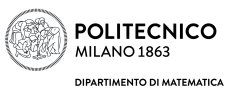M. Hinz
Variability of mappings, and its applications
Given two finite Borel measures on $\mathbb{R}^n$, the finiteness of their mutual Riesz (interaction) energy of a certain order means that they cannot be too concentrated at the same spots. If one of these measures is the occupation measure of a H\"older continuous or (low) Sobolev regular mapping $u$ and the other is the gradient measure of a BV-function $\varphi$, then the finiteness of the mutual Riesz energy implies that the nonlinear composition $\varphi\circ u$ is well defined and of a certain Sobolev regularity. The basic mechanism is almost the same as taking traces on fractals. We briefly discuss applications of this principle in stochastic analysis and, if time permits, mention some new related optimization problems. The talk is based on joint work with Jonas T\"olle and Lauri Viitasaari (both Aalto University).
T. Isola
Self-similar schemes
Starting with three compact Hausdorff spaces $X_0$, $X_1$, $Y$, and two maps $\varphi$ and $\pi$, which say how to glue $Y$ copies of $X_0$ to obtain $X_1$, we construct a sequence $\{ X_n \}$ of compact Hausdorff spaces, and a suitable limit compact Hausdorff space $X_\infty$, which is some sort of self-similar space and a fixed point of a functor associated with the given data. Specialising our construction to $Y$ a finite set, we recover the self-similar structures of Kigami, in a purely topological context.
J. Kigami
Yet another construction of “Sobolev spaces” on metric spaces
The counterpart of “Sobolev spaces” on metric spaces has been intensively studied for the last 20 years after the pioneering works by Cheeger, Hajlasz, and Shanmugalingam. The mainstream of the ideas is to use the local Lipschitz constant of a function as a suitable substitute for its gradient. However, a recent study by Kajino and Murugan on the conformal walk dimension revealed that the Dirichlet form associated with the Brownian motion on the Sierpinski carpet can not be a Sobolev space in this sense. In this talk, we will propose a new way of constructing “Sobolev spaces” on compact metric spaces including the Sierpinski carpet.
M. Lapidus
Iterated Weierstrass Fractal Drums Their Fractal Complex Dimensions, Zeta Functions and Cohomology
In this talk, we will give an overview of some aspects of a recent joint work with Claire David (University Paris-Sorbonne, Paris, France) developed in a series of seven or eight papers, as well as in a book in preparation, building on—as well as significantly modifying and extending-- the earlier theory of complex dimensions for fractal strings (see, e.g., the book by M. L. Lapidus and M. van Frankenhuijsen, Fractal Geometry, Complex Dimensions and Zeta Functions, 2nd revised and enlarged edition, Springer, 2013; FGCD, in short) and its higher-dimensional counterpart (see, e.g., the book by M. L. Lapidus, G. Radunovic and D. Zubrinic, Fractal Zeta Functions and Fractal Drums, Springer, 2017). We focus on the prototypical example of the family of Weierstrass curves, which are nowhere differentiable curves exhibiting a generalized form of (nonlinear and non-contractive) self-similarity and are extremely complex geometric and analytic objects. We define and study appropriate fractal zeta functions, the so-called (effective, polyhedral) local and global zeta functions, associated, respectively, with the prefractal graph approximations of the curve and with the entire curve. (In the process, an appropriate choice of a sequence of critical scales--called cohomology infinitesimal and determined by the underlying geometry--is essential.) We then precisely determine the exact complex fractal dimensions of the Weierstrass curve. This requires introducing and working with a novel notion of polygonal neighborhoods rather than just working with the standard tubular neighborhoods of the curve. A new feature of this work is that--after sufficiently many iterations-- the prefractal approximations of the curve are themselves fractal, in the sense of the theory of complex dimensions. Namely, they have (infinitely many) nonreal complex dimensions and therefore have natural intrinsic oscillations (or vibrations). Finally, if time permits, we will discuss the fractal cohomolgy of Weierstrass curves, as defined in this series of papers and defined via a suitable discrete version of the standard smooth calculus for differential forms. We precisely characterize the fractal (local and global) cohomology groups of these fractal curves in terms of certain fractal power series expansions expressed in terms of the underlying complex dimensions. We also begin developing a precise dictionary between this work and many other parts of mathematics (and physics), including topology, smooth, real and complex differential geometry, dynamical systems, algebraic geometry, arithmetic geometry and number theory, along with statistical physics and the theory of completely integrable nonlinear PDEs. Close connections appear with some of the features expected in FGCD and, especially, with the conjectures made in the author’s book (MLL, In Search of the Riemann Zeros, Amer. Math. Soc., 2008) regarding fractal flows and fractal cohomology. It is expected that the theory developed in this work can be applied to a wide variety of fractal curves (such as the snowflake curve) and of higher-dimensional “fractal manifolds”. See one of the papers (on the Koch curve) by MLL and C. David, along with a book in preparation by those same authors.
G.D.P. Mantica
Fractal spectral measures and dynamics: how problems never age and shape generations
It was the best of problems, it was the worst of problems, it was attacked by rigor, it was tackled by foolish intuition; some saw its numerics with belief, some with incredulity. It was a moment of Light, it was a season of Darkness. It was the spring of hope for youngsters, it was the winter of despair for elders.
We had all theories before us, we had no proofs before us, we were all going direct to tenure, we were all going the other way in short, that period was so far like the present period, that some authorities pretend that things are settled this way for ever.
G. Mola
Inverse problems in irregular domains: approximation via Mosco convergence
We consider inverse problems in an irregular domain $\Omega$ and in suitable approximating domains $\Omega_n$, for $n\in\mathbb{N}$, respectively. After proving well-posedness results, we prove that the solutions of the approximating problems converge in a suitable sense to the solution of the problem on $\Omega$ via Mosco convergence. We also present some applications.
This is a joint work with S. Creo, M. R. Lancia and S. Romanelli.
D.D. Noja
The KdV equation and its linearization on a star graph
The KdV equation modellizes the shallow water flow in channels. It is a natural question to ask what happens when the channel branches.
I will discuss the analysis of the problem for the linear part of the KdV equation, the so-called Airy equation, giving results about the generation of contraction semigroups in dependence of the geometrical properties of the graph representing the branching channel and of the boundary conditions at the junction. Moreover, I will also give some remarks about the existence of travelling waves for the complete KdV equation.
R. Peirone
Distances on fractals
Some natural distances are introduced on fractals. Problems about the Lipschitz properties of the maps defining the fractal and their inverse are discussed.
A. Posilicano
The semi-classical limit on a quantum star-graph
We consider the evolution of quasi-Gaussian coherent states on a quantum star-graph with Kirchhoff boundary conditions at the vertex. It turns out that in the semi-classical regime this quantum dynamics is well approximated by that generated by a Liouville operator which is a suitable self-adjoint extension of the symmetric operator corresponding to classical free motion in the vertexless graph.
Joint work with Claudio Cacciapuoti and Davide Fermi.
G. Radunovic
Support measures and complex dimensions in fractal geometry
We study new geometrical functionals for arbitrary compact subsets of the $d$-dimensional Euclidean space called the basic and support functionals. The basic functionals are tightly related to the general Steiner-like formula involving the support measures of the given set. By introducing appropriate critical rescaling exponents of the basic functionals we connect them to the upper Minkowski dimension of the given set. On the other hand, a Steiner-like formula for arbitrary compact sets can also be derived by using the theory of complex fractal dimensions and the associated distance and tube zeta functions. In order to connect and complement these two theories, we introduce new (fractal) zeta functions corresponding to the basic and support functionals and provide functional equations connecting them to the classical fractal zeta functions. This provides a first glimpse on how the complex dimensions are generated by the basic functionals of the set. Furthermore, we also comment on the connection to the theory of fractal curvature measures. We provide interesting examples to support our results.
This a joint work with S. Winter.
A. Rozanova-Pierrat
Inverse and scattering problems on extension domains
Solving the direct and inverse problems involving the partial differential equations on domains with non-Lipschitz and fractal boundaries needs adapting the functional analysis and the usual methods developed for the regular boundary case. Revisit of the definition and properties of the trace operator on the boundary allows the introduction of the Poincaré-Steklov and layer potential operators for extension domains independent of the boundary measure.
We characterize them as isometries with respect to the trace space. Then, as an application, we treat the Calderon inverse problem for general extension domains.
This is joint work with C. Bardos (Université Paris Cité), M. Hinz (University of Bielefeld), G. Claret (CentraleSupélec) and A. Teplyaev (University of Connecticut).
A. Setti
${\bf L^{p}}$-parabolicity of Riemannian manifolds
We introduce a notion of $L^p$-parabolicity of Riemannian manifolds defined in terms of nonlinear $L^p$-capacities which extends the usual notion of parabolicity (corresponding to $p=1$) to the whole range $1\leq p\leq \infty$. $L^p$-parabolicity turns out to be equivalent to the $L^q$-Liouville property for positive superharmonic functions, where $p$ and $q$ are H\"older conjugate exponents, and, when $p=2$ it coincides with the biparabolicity as defined by S.Faraji and A. Grigor'yan. We also provide a new capacitary characterization of the $L^1$-Liouville property. Finally we obtain an almost optimal volume growth conditions implying $L^p$-parabolicity for $1 This is join work with A. Grigor'yan and L.F. Pessoa.
A. Teplyaev
Convergence of diffusions and eigenvalues in rough domains
Dirichlet form analysis gives powerful tools to study diffusion in non-smooth settings, and Mosco convergence is a standard approach to study approximations. However, Mosco convergence may not be sufficient to understand finer properties, such as convergence of eigenvalues and small deviations of diffusion processes. The talk will present two recent results that strengthen Mosco convergence of Dirichlet forms. One result deals with Euclidean extension domains with irregular, or fractal, boundaries (joint work with Michael Hinz and Anna Rozanova-Pierrat). The other result deals with small deviations in sub-Riemannian situations (joint work with Marco Carfagnini and Masha Gordina).
A. Vélez-Santiago
Global regularity of the inhomogeneous Wentzell heat equation with discontinuous data
We discuss some recent new results concerning the global regularity for a inhomogeneous generalized elliptic and parabolic Wentzell-type boundary value problem with discontinuous data and lower-order coefficients. The aim of this talk is to discuss some recent results related to the global uniform continuity of weak solutions of the Wenzell diffusion equation under minimal assumptions.





